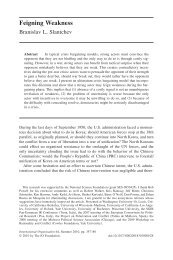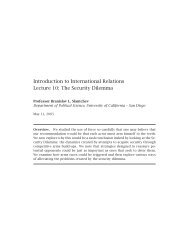Game Theory: Repeated Games - Branislav L. Slantchev (UCSD)
Game Theory: Repeated Games - Branislav L. Slantchev (UCSD)
Game Theory: Repeated Games - Branislav L. Slantchev (UCSD)
You also want an ePaper? Increase the reach of your titles
YUMPU automatically turns print PDFs into web optimized ePapers that Google loves.
Let p be the probability that player 1 chooses U and q be the probability that he chooses<br />
M. Player 2’s expected payoff from L is p − 3q + 1, and his payoff from R is p + 5q − 3. By<br />
inspection (or equating the payoffs), we find that p = q = 1 /2 is the worst player 1 can do to<br />
player 2, in which case player 2’s minimax payoff is 0. The set of strictly rational payoffs is<br />
the subset of feasible payoffs where u1 ≥− 1 /2 and u2 ≥ 0.<br />
4.2 Subgame Perfection<br />
Consider now an infinitely repeated game G(δ) with the stage game shown in Fig. 5 (p. 17).<br />
C D<br />
C 2,2 0,3<br />
D 3,0 1,1<br />
Figure 5: The Stage <strong>Game</strong>.<br />
Are the following strategy profiles, as defined in the lecture notes, subgame perfect? Show<br />
your work and calculate the minimum discount factors necessary to sustain the subgame<br />
perfect equilibrium, if any.<br />
• (TFT,TFT). Hint: partition payoffs and try using x = δ2 .<br />
The game has four types of subgames, depending on the realization of the stage game<br />
in the last period. To show subgame perfection, we must make sure neither player has<br />
an incentive to deviate in any of these subgames.<br />
1. The last realization was (C, C). 10 If player 1 follows TFT, then his payoff is<br />
(1 − δ)[2 + 2δ + 2δ 2 + 2δ 3 +···] = 2.<br />
If player 1 deviates, the sequence of outcomes is (D,C),(C,D),(D,C),(C,D),...,<br />
and his payoff will be<br />
(1 − δ)[3 + δ + 3δ 2 + δ 3 + 3δ 4 + δ 5 +···] = 3<br />
1 + δ .<br />
(Here we make use of the hint. The payoff can be partitioned into two sequences,<br />
one in which the per-period payoff is 3, and another where the per-period payoff<br />
is 1. So we have (letting x = δ2 as suggested):<br />
10 This also handles the initial subgame.<br />
3 + 0δ + 3δ 2 + 0δ 3 + 3δ 4 + 0δ 5 + 3δ 6 +···<br />
= 3 + 3δ 2 + 3δ 4 + 3δ 6 +···+0δ + 0δ 3 + 0δ 5 +···<br />
= 3[1 + δ 2 + δ 4 + δ 6 +···] + 0δ[1 + δ 2 + δ 4 +···]<br />
= (3 + 0δ)[1 + δ 2 + δ 4 + δ 6 +···]<br />
= 3[1 + x + x 2 + x 3 + x 4 +···]<br />
<br />
1<br />
= 3<br />
1 − x<br />
3<br />
3<br />
= =<br />
1 − δ2 (1 − δ)(1 + δ)<br />
17








